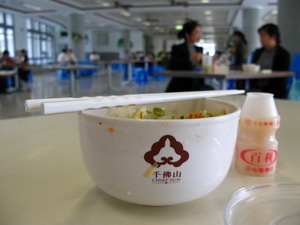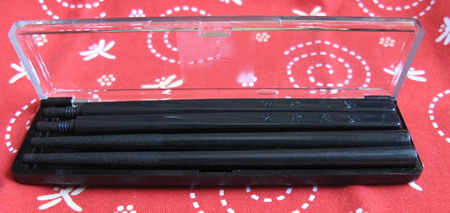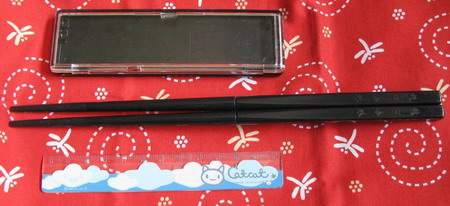Japanese-style cute bento may be all the rage, but the Taiwanese also have a strong bento culture, or rather 弁当 bento–> 便當 bian4 dang1 (different ways of writing the same kanji Chinese characters, and pronounced in Mandarin).
Fifty years of Japanese colonial rule in Taiwan until the end of the Second World War has left a strong legacy of Japanese culture. However, as much as bian dang are very much a part of everyday life in Taiwan today, they are quite distinct from Japanese bento.
As you can see in these photos (which also include photos of Japanese bento – don’t get confused), Taiwanese bian dang are typically packed in shallow, rectangular cardboard boxes, which are held shut by two rubber bands stretched over the diagonal corners, and which can be used to hold down a pair of disposable chopsticks as well. The type of food is also rather different, being stir-fried or braised Chinese dishes, often brown in colour from the soya sauce with some green vegetables; all cooked foods. Not as colourful as Japanese dishes, functional rather than aesthetic.
Without the Japanese focus on fussy, intricate – sometimes outlandish – presentation of foods in the bento box, the Taiwan bian dang is a more likely candidate for being influenced by the Buddhist principles of simplicity, concern for the environment and vegetarianism. Japanese Zen vegan cooking, shojin ryori (see also here), is a more rarified expression of these Buddhist principles in food, which I understand is practised within the confines of temples rather than by lay people as part of everyday life.
The international Buddhist organisation, the Tzu Chi Foundation, which is based in Hualian, Taiwan, produces its own line of plastic Buddhist-inspired bian dang utensils [if you read Chinese, please view the original Tzu Chi Taiwan site], which are promoted as being reusable and hence environmentally-friendly.
When I visited Tzu Chi University in Hualian, I found many of the students toting these lunch sets, even though there was a canteen. It’s because the canteen provides food but not utensils. To eat there, you must bring your own bowl and chopsticks, and there are sinks outside the canteen for you to wash up when you are done.

Lunch at Tzu Chi University – no disposable utensils!
The minimalist, Zen styling of the Tzu Chi bian dang range [see also here] is rather attractive but I’ve always found it impractical that the lids don’t shut tight – a bit of pressure and they’re off, and because they are bowl-shaped, you can’t use elastic bands to hold them shut. However, I love the Tzu Chi folding chopsticks :). There are two types: the more more fancy type operates like a click-type ballpoint pen! It’s very clever but I wasn’t sure about washing inside the mechanism so my choice is the cheaper screw-version, which comes in two halves and can be screwed together, In Singapore, it’s available from Tzu Chi’s Jing-Si Cafe; about S$5 for the screw-type, which comes in black or ivory colour.
Tzu Chi folding chopsticks, measured next to 12cm ruler


Aside from the small size when packed, the other advantages of these chopsticks are:
1) they are full-sized when assembled (as compared to the normal non-folding kids/travel-sized Japanese ones that come in attractive plastic cases).
2) they are Chinese-style chopsticks with blunt ends. I’m not used to the pointed Japanese-style chopsticks and find them difficult to manipulate.
3) the narrow ends of the chopsticks have a rough texture to make it easier to pick up food.
Filed under: bento 便當, Chinese, consumer watch, food culture, Japanese |



Hi, can you please tell me where I can get the chopsticks, the click-type? I have a pair which a friend gave and I absolutely love it, and would love to give friends a pair too.
Thanks, C.
Dear Carolyn,
The click-type is also available from Tzu Chi — try the Tzu Chi online shop pages linked above.
If you live in Singapore, I’ve also seen the click-type on sale at Isetan.
Wouldn’t it be possible to use rubber bands on the bowl-shaped boxes by putting them at a 90 degree
angle to each other?
Love those chopsticks btw; much more practical
than the ones I have here.
-enk
Hi Justvegging, I think the rubber bands would slip off a round container, although I haven’t really experimented myself.
Actually, the extending chopsticks don’t have any mechanism inside. When you hit the button, it only pushes the inner piece away from the grip so that gravity brings it down. When it falls to the most extended position, it is mere friction that holds the extension in place. On the downside, (1) this means that you have to extend the chopsticks while held vertically or the inner piece will not have enough momentum to friction-lock securely and it might retract while you are eating, (2) you may think this is less cool than you thought.
But on the upside, you CAN take it apart and wash the inside because there is no mechanism, and it’s extremely functional as-is as long as you remember to hit the button while held vertically.
ps. my personal preference is actually the two-piece snap-in version that Tzu Chi makes. It is both fast to put together as well as does not suffer from the problem of accidental retraction that those other star trek chopsticks do.
Yzl, thanks so much for your chopstick reviews!
I recently bought the two-piece snap-in Tzu Chi chopsticks. At the Tzu Chi Jingsi shop in Hualian, I was told that these are the new improved design, in response to customer feedback exactly as you say — because the retractable chopsticks easily snap back in when one puts pressure on the ends. When I get time, I’ll do a posting on the new design Tzu Chi chopsticks.